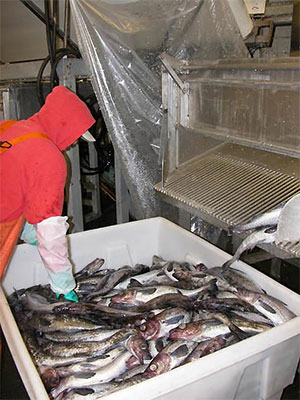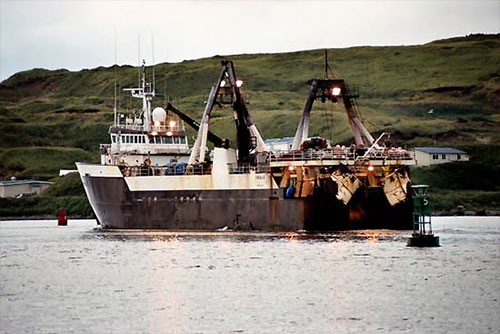
Pollock fishermen may struggle to maintain catch numbers as oceans changeBy LAUREN FRISCH
June 14, 2016
Changes in the ocean and its resources have dramatic implications for communities and economies that rely on them. Jordan Watson, a PhD student at the UAF School of Fisheries and Ocean Sciences, is studying how Alaska’s commercial pollock industry is responding to changes in the ocean. The results may be used to consider how fisheries policies and regulations can increase the capacity of fishing operations to respond to change.
Watson’s adviser, SFOS professor Franz Mueter, explains, “Essentially he’s trying to model the behavior of fishermen similar to the way people model the behavior of predators in an environment.” Watson, Mueter and Alan Haynie of the Alaska Fisheries Science Center are looking at vessel locations, observer data and fish landings to consider how fishing trips vary based on environmental conditions and fish numbers. The Alaska Department of Fish and Game reports that the state’s seafood industry is estimated to bring in about $5.8 billion annually, and contributes approximately 78,500 jobs to Alaska’s economy. Maintaining sustainability in the industry depends on understanding how various fleets are likely to be affected by changes in the ocean, and what kinds of policies can be enforced to help fishermen adapt to these changes. “If agencies are going to implement new regulations that might cause the fishermen to have to change they way they fish, we want to understand how the change will impact fishing operations,” Watson said. “We want to evaluate how behavior changes in response to different things.” “The topic fell in my lap,” Watson said. Prior to this, his research focused on reducing bycatch. “I’ve never studied human behavior before. Since pollock fleets worry a lot about bycatch, we thought that looking at fishermen’s behavior might also help us identify ways to help reduce bycatch.” Watson initially took on this project as a full-time job with the Pacific States Marine Fisheries Commission, and eventually decided to make it a PhD project as well. He has funding from Alaska Sea Grant, the NMFS Office of Science and Technology, and the North Pacific Research Board. Watson is working with location data from GPS trackers called vessel monitoring systems, which are required aboard every commercial pollock vessel to learn where they are going and how long they are out at sea. His data span 2003 through 2015. He is also working with observer data and fish landings to consider how fishing trips vary based on environmental conditions and fish numbers.
A commercial pollock vessel.
Using fish landings data alongside vessel location also helps Watson evaluate fishing efficiency by quantifying the number of fish caught per trip. The amount of data involved is not the only complicated aspect of this research. There is no cookie-cutter definition of what it means to be an Alaska fisherman, which makes it harder to track how industry-wide practices are changing. Some fishermen hold permits for multiple species or regions in Alaska. Others also work out of state in Washington or Oregon. If conditions worsen for a certain region or fishery, fishermen could switch regions or fisheries, or adjust the time of year that their vessel operates. “One thing we’re hoping to understand better by the end of the project,” said Watson, “is the propensity for fishermen to seek alternative economic opportunities when conditions get tough.” The results of this project will be valuable to managers who are tasked with making decisions to encourage sustainable fisheries. Quantifying how much less efficient pollock fleets are when pollock numbers are lower may help managers create strategies to preserve the economic prosperity of the fleet while maintaining sustainable stocks. “We often have a pretty good idea or can make a reasonable guess about how changes in the ocean might affect a certain species, but we don’t really know how it might affect fishing communities around the coast that rely on the industry,” Mueter said. “This research might provide a tool for agencies to evaluate the impacts of different regulatory actions on fishermen and communities.”
This article is provided as a public service by Alaska Sea Grant, a statewide marine research, education, and outreach program. Alaska Sea Grant is in partnership between the University of Alaska Fairbanks and the National Atmospheric and Oceanographic Administration. Representations of fact and opinions in comments posted below are solely those of the individual posters and do not represent the opinions of Sitnews.
|
|||

